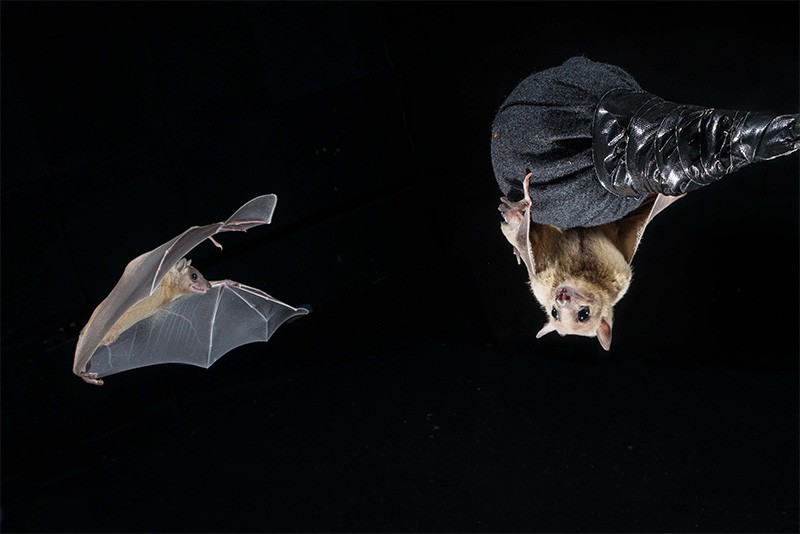
Brief News of Cognitive Navigation (2018-002)
1. ‘Bat-nav’ reveals how the brain tracks other animals
By Alison Abbott, published on the Nature News in Jan 12, 2018

-
The brain’s navigation system — which keeps track of where we are in space — also monitors the movements of others, experiments in bats and rats suggest.
-
Neuroscientists report individual brain cells that seem specialized to track other animals or objects. These cells occur in the same region of the brain — the hippocampus — as cells that are known to map a bat’s own location.
-
The unexpected findings deepen insight into the mammalian brain’s complex navigation system.
-
Bats and rats are social animals that, like people, need to know the locations of other members of their group so that they can interact, learn from each other and move around together.
-
One subset of cells fired in response to the observer bat’s own position as it flew, indicating recognition of ‘self’ location. These were regular place cells.
-
Another subset fired in response to the position of the other flying bat; the researchers called these social place cells.
-
Whether social place cells are exclusively for tracking other members of the same species, or whether they are part of a system of hippocampal cells that encode all sorts of trajectories — be they those of animals or objects — isn’t yet clear, says Moser. “But in either case, it would be exciting.”
For further info on the Nature site.
David B. Omer, Shir R. Maimon, Liora Las, Nachum Ulanovsky. Social place-cells in the bat hippocampus. Science 12 Jan 2018: Vol. 359, Issue 6372, pp. 218-224. DOI: 10.1126/science.aao3474
Teruko Danjo, Taro Toyoizumi, Shigeyoshi Fujisawa. Spatial representations of self and other in the hippocampus. Science 12 Jan 2018: Vol. 359, Issue 6372, pp. 213-218 DOI: 10.1126/science.aao3898
Neuroscience: Brains of Norway
Sat-nav neurons tell bats where to go
2. How to see a memory
By Helen Shen, published on Nature News in Jan 10, 2018
-
Every memory leaves its own imprint in the brain, and researchers are starting to work out what one looks like.
-
For someone who’s not a Sherlock superfan, cognitive neuroscientist Janice Chen knows the BBC’s hit detective drama better than most. With the help of a brain scanner, she spies on what happens inside viewers’ heads when they watch the first episode of the series and then describe the plot.
-
Powerful technological innovations in human and animal neuroscience in the past decade are enabling researchers to uncover fundamental rules about how individual memories form, organize and interact with each other.
-
Using techniques for labelling active neurons, for example, teams have located circuits associated with the memory of a painful stimulus in rodents and successfully reactivated those pathways to trigger the memory.
-
Such findings could one day help to reveal why memories fail in old age or disease, or how false memories creep into eyewitness testimony. These insights might also lead to strategies for improved learning and memory.
-
Scientists have worked out some basic principles of this broad framework. But testing higher-level theories about how groups of neurons store and retrieve specific bits of information is still challenging.
-
Researchers now want to explore how specific recollections evolve with time, and how they might be remodelled, distorted or even recreated when they are retrieved.
For further info on the Nature site.
About
CogNav Blog
New discovery worth spreading on cognitive navigation in neurorobotics and neuroscience
Recent Posts
- How to build a bio-inspired hardware implementation of an analog spike-based hippocampus memory model?
- How does the brain select what to remember during sleep?
- How hippocampal activity encodes numerous memories of specific events in life?
- How egocentric coding properties arise from its presynaptic inputs, and how egocentric cells represent items across different behavioral contexts?
- How the medial entorhinal cortex develops during learning and influences memory?
Tags
Categories
- 3D Movement
- 3D Navigation
- 3D Path Integration
- 3D Perception
- 3D SLAM
- 3D Spatial Representation
- AI Navigation
- Bio-Inspired Robotics
- Brain-Inspired Navigation
- Cognitive Map
- Cognitive Navigation
- Episodic Memory
- Excerpt Notes
- Flying Vehicle Navigation
- Goal Representation
- Insect Navigation
- Learning to Navigate
- Neural Basis of Navigation
- Path Integration
- Path Planning
- Project
- Research Tips
- Robotic Vision
- Self-Flying Vehicles
- Spatial Cognition
- Spatial Cognitive Computing
- Spatial Coordinate System
- Spatial Memory
- Time
- Unclassified
- Visual Cortex
- Visual Cue Cells
Links
- Laboratory of Nachum Ulanovsky
- Jeffery Lab
- BatLab
- The NeuroBat Lab
- Taube Lab
- Laurens Group
- Romani Lab
- Moser Group
- O’Keefe Group
- DoellerLab
- MilfordRobotics Group
- The Space and Memory group
- Angelaki Lab
- Spatial Cognition Lab
- McNaughton Lab
- Conradt Group
- The Fiete Lab
- The Cacucci Lab
- The Burak Lab
- Knierim Lab
- Clark Spatial Navigation & Memory Lab
- Computational Memory Lab
- The Dombeck Lab
- Zugaro Lab
- Insect Robotics Group
- The Nagel Lab
- Basu Lab
- Spatial Perception and Memory lab
- The Neuroecology lab
- The Nagel Lab
- Neural Modeling and Interface Lab
- Memory and Navigation Circuits Group
- Neural Circuits and Memory Lab
- The lab of Arseny Finkelstein
- The Epstein Lab
- Gu Lab (Spatial Navigation and Memory)
- Fisher Lab (Neural Circuits for Navigation)
- The Alexander Lab (Spatial Cognition and Memory)
- Harvey Lab (Neural Circuits for Navigation)
- Buzsáki Lab
- ……
